08.04.2022
Superfood or super-toxic—can cats eat blueberries?
We all want to spoil our felines occasionally, and treating them to the healthy snacks we love might seem like the best way to do it.
Cats will usually try anything once, but they know what is good for them and what should be avoided.
So can cats eat blueberries? Read on to find out whether what’s good for humans is as good for your feline.
What do blueberries contain?
Blueberries are seen as a superfood for humans, as they contain ample amounts of:
- Vitamins C and K
- Antioxidants for cell health
- Iron, zinc, phosphorous, calcium, magnesium, and manganese to aid bone structure
- Potassium to lower blood pressure
- Fibre for gut health
While these constituents give blueberries a deservedly good reputation as food for people, cats have vastly different nutritional requirements.

Berries of all kinds may be enticing but contain huge amounts of sugar
Source: Pixabay
Should cats eat blueberries?
Most berries are non-toxic to felines, but fruit, while mostly not forbidden, is not part of a cat’s natural nutrition and will only be eaten in the wild if felines are lacking something in their diet and can’t find a better source.
Berries are not a substitute for an appropriate diet. Whether you choose dry, semi-moist, wet, or even raw food, balanced and complete nutrition is essential to keep your cat healthy and full of energy.
Blueberries contain large amounts of carbs, whether in the form of fructose or as fibre. Sugar from carbs is one thing your cat should avoid at all costs. The biggest issue cats will face through regularly indulging in blueberries is weight gain as a result of eating too much sugar.
What effect can too much sugar have on a cat?
Sugar from carbohydrate-heavy food, such as fruit, is the worst ingredient for your cat, potentially leading to weight-related conditions, such as:
- Diabetes and pancreatitis
- Arthritis and mobility issues
- Heart problems
Diabetes and pancreatitis
When a cat eats carbs, the body is quickly flooded with sugars, and the pancreas has to release large quantities of insulin to manage blood sugar levels.
Over time, this can cause undue pressure on the pancreas, potentially leading to acute pancreatitis or chronic Type-2 diabetes.
These are serious conditions and can only be managed through a strict diet, insulin injections, and veterinary supervision.
Arthritis and mobility issues
Gaining poundage can be a vicious circle for a cat.
Carbs can cause lethargy as cats’ bodies experience a sugar rush followed by a rapid slump in energy levels. A lethargic cat will not work off the calories consumed, and this downward—or outward—weight spiral can lead to joint degeneration, arthritis, and loss of mobility.
Older cats will often suffer from reduced mobility and lower energy levels, but adult cats up to the age of ten should be able to move around without any difficulty.
High carb intake can quickly lead your cat down the route of obesity, at which point you will need to act quickly to introduce a healthier diet and more regular activity.
Heart problems
Obesity and heart problems go hand in hand as the heart has to work harder to haul any excess weight around.
The symptoms of heart problems in cats can include:
- Difficulty breathing
- Seizures
- Acute paralysis of the hind legs
If any of these occur, you need to seek the help of a vet immediately.
You should also bear in mind that indoor and neutered cats are particularly prone to weight-influenced issues—if your cat falls into these categories, you should avoid snacks, such as blueberries, altogether.
Prevention is always better than cure, so helping your feline lose weight by reducing sugar intake is a great way of showing your love and avoiding potential future health issues.
Even though the temptation to treat your cat blueberries, apples, grapes, strawberries, bananas, or other seemingly healthy snacks may be strong, the best thing you can do for your feline is to offer appropriate nutrition and nothing but.

“Who are you calling fat???”
Source: Pixabay
What do cats need to eat?
Unlike humans, cats are obligate carnivores, meaning that they can’t get much nutritional value from blueberries. Their bodies have evolved to get nourishment most efficiently by eating:
- Animal protein
- Animal fat
Animal protein
Protein is made up of combinations of amino acids.
When any living organism consumes protein, it recombines the amino acids taken on board to provide building blocks for:
- Muscles
- Skin and coat
- Organ structure and maintenance
Cats are most efficient at using animal protein to deliver the amino acids they need (e.g. taurine). Vegetable protein sources aren’t the best solution as your cat will need to consume considerably larger quantities of plant protein to cover their requirements.
The efficiency with which a cat can metabolise different protein sources is measured by the protein’s biological value (BV). Even the best plant protein—soya—is nowhere near as easy for a cat to metabolise as the worst meat source, as follows:
|
Protein source |
Biological value |
|
98% |
|
|
94% |
|
92% |
|
|
87% |
|
|
68% |
|
|
Below 65% |
Blueberries are not a good source of protein for cats and should not be thought of as adequate food.
Animal fat
After protein, cats get additional energy from various sources, notably:
- Carbohydrates
- Fat
Carbs deliver sugars that can be used for immediate energy requirements, like hunting or running away from danger. If the energy from sugar is not used immediately, it will be stored as fat cells. This can quickly lead to domestic cats putting on weight rapidly as they do not need to hunt for their food.
Fat is a healthier source of energy for felines as it delivers energy that can be released more slowly. Animal fat is also excellent for:
- Providing essential fatty acids for cell health
- Improving the taste of the food
The taste of animal fat drives cats wild, and this evolutionary trick means that they are more likely to crave food that is healthy for them.
In the wild, cats hunt small rodents, birds, and even reptiles or slugs, all of which are primarily made up of animal protein and fat. Carb-induced obesity doesn’t occur in the wild, so it shouldn't happen at home either.
How can you tell whether cat food is good?
The best cat foods are simple, natural, and full of exactly what a cat would eat in the wild.
Cat food should be made up of:
You can check what goes into a good cat food with a bit of research, either online or in-store. All the information you need to make a healthy choice for your feline is freely available.
The three elements you can easily check are the:
- Product description
- Ingredients list
- Guaranteed analysis
Product description
The way manufacturers describe their products is governed by strict regulations. Pet food producers have to stick to the following rules on product descriptions:
|
Flavour designation in the product description |
Percentage of the named meat in the product |
|
“Flavoured with” |
Up to 4% |
|
“With” |
4%–14% |
|
“Rich in” |
14%–26% |
|
“XYZ,” such as Untamed Chocka Chicken |
Over 26% |
Ingredients list
Food laws across Europe stipulate that every ingredient in pet food has to be listed in descending order by volume.
A defined meat source should appear in first place on the list, but you should be aware of a few tricks that some manufacturers play to get around the regulations:
- Ingredient splitting—Pet food makers often split single ingredients by production method. As an example, you may see corn gluten, cornmeal, and ground corn listed as separate ingredients, although they are all corn. The result is that each ingredient is smaller in volume than the meat source in the product, although the total volume of corn may exceed that of meat
- Vague descriptors—Any product that lists vague sources of meat is suspicious. If you see terms like “meat and animal derivatives” in cat food, you have no guarantee of what has actually gone into the product. If your cat is fussy, has a sensitive stomach, or is prone to food allergies, you should steer clear of any food that isn’t upfront about its ingredients
- Scientific mumbo-jumbo—Long, scientific ingredient names are an indication of several possible issues. If a manufacturer has to include supplementary vitamins and minerals, this could be an indication that the basic ingredients are of inferior quality. Scientific names can also mask artificial additives or flavour enhancers, many of which are not healthy for your cat
The best cat foods feature short, highly concise ingredients lists. This is your guarantee that:
- The product is based on a natural recipe, similar to the B.A.R.F. or home-made philosophy
- The formula does not change based on the price of ingredients
Guaranteed analysis
The guaranteed analysis tells you what percentage of each food group is in the product.
Manufacturers have to provide a guarantee for every product’s percentage of:
- Protein
- Fat
- Carbs
- Moisture
This information isn’t particularly helpful independently, as a high protein percentage may be made up primarily of vegetable protein. If you compare the guaranteed analysis with the ingredients list, you can get a good idea as to the quality of the product.
A short ingredients list with meat as the first ingredient and a guaranteed analysis listing a high percentage of protein are good indicators that the product is a high-quality option for your feline.

“This is more like it!”
Image (c) Untamed
Is Untamed good for your feline?
Untamed cat food ticks all the nutritional boxes you should be looking for.
Each Untamed recipe started out as a tailor-made meal, and the philosophy behind Untamed involves:
- Large amounts of exclusively animal protein
- Vet-formulated products
- Human-grade ingredients
Large amounts of exclusively animal protein
Whether you choose Untamed meals in gravy or jelly, you can rest assured that your cat will be getting up to twice the amount of animal protein contained in other commercial cat foods.
With this amount of goodness, you can expect added health benefits, such as:
- Avoidance of urinary tract infections (UTIs), like cystitis and bladder stones
- Reduction in shedding, meaning fewer issues with hairballs
- Better gut health, avoiding issues such as diarrhoea, nausea, and irritable bowel syndrome (IBS)
- Appropriate energy and nutrient levels, whether for kittens to ensure healthy growth after weaning, for adults, or for seniors to keep them active and strong
Vet-formulated products
Untamed works closely with vets to make sure every recipe delivers exactly what your cat needs in as tasty a form as possible.
Your feline’s nutritional needs are covered from A to Z, and you should see the difference in your cat’s:
- Energy levels
- Resilience
- Zest for play and adventure
Human-grade ingredients
Your cat deserves the best of the best, so we make sure that every ingredient in Untamed cat food is of the highest quality and is free from known allergens.
This is your security in avoiding:
- Stomach upsets
- Food poisoning
- Discomfort, heaving, or nausea
Untamed also strives to be an ethical manufacturer. Our packaging is 100% recyclable, and our meat and fish are sourced from cruelty-free, dolphin-safe, and sustainable suppliers. We are also a carbon-neutral company, so your cat’s health and happiness go hand in hand with that of the planet.
All this means that your best course of action is to give Untamed a try as soon as possible!
How can you get your paws on Untamed?
You don’t have to go trawling the shops for Untamed—we ensure you always have enough of your feline’s favourite.
You can order our cat food online without stressing—all you have to do is:
- Tell us all about your cat
- Customise a meal plan
- Order your first Untamed pack online
Once your trial pack arrives on your doorstep, your kitty can start exploring the taste sensations in every tin of Untamed—even cats that have never normally eaten wet food will go wild!
You don't have to worry about ordering supplies again and again. Our monthly home-delivered cat food will keep you stocked up for as long as you want. Happy Untamed cat parents report the following positive changes:
|
Timeline |
The Untamed effect |
|
Within a week |
You will see your cat become more lively, and you may notice less mess in the litter tray |
|
After two months |
You should notice your feline being more playful and full of energy |
|
Within four months |
Your cat’s coat should start to shine, and you should notice fewer hairballs |
|
For life |
Your feline should remain sleek, active, and contented, even in later years |
You may also see that your kitty is no longer as interested in begging for snacks, such as blueberries.

“I just KNOW this works every time!”
Source: Pixabay
What’s the bottom line on blueberries and other treats?
If your kitty is a persistent beggar and your leg is suffering from incessant headbutts, switching to a healthier diet can often solve the problem.
Giving the occasional treat is fine, but whatever complementary food you allow your feline to eat should make up no more than 10% of the total calorie intake.
There are some things you should never offer your cat as they can lead to serious problems. These include:
- Chocolate, cocoa, or anything containing cacao beans
- Coffee or other stimulants
- Alcohol of any kind
- Onions, chives, or garlic
- Citrus fruit
- Dough or yeast products
This is not an exhaustive list, but you may have to develop a slightly harder heart and get into the habit of clearing away immediately after cooking, making sure your snacks aren’t left lying around and keeping potentially toxic items out of kitty’s reach.

“Heaven in a box—who needs blueberries?”
Image (c) Untamed
Can you do anything about begging for snacks?
You can help alleviate begging tendencies by trying the following:
- Ensure your cat’s nutritional needs are being met—The better the food you serve your cat, the less you will experience begging. A frequent example is cats’ occasional tendency to eat grass. Their craving often disappears when they are regularly fed high-quality meals
- Give your feline more attention—Begging may be a sign that your cat wants attention. You should try to engage more with them through play, hunting exercises, or stimulation with toys or laser pointers
- Check for hyperthyroidism—This is an affliction that makes it impossible for cats to control their metabolism. It can be managed with your vet’s help, but one of the early symptoms is constant hunger combined with seeming lethargy
If you have ruled out any illness and you’re convinced your cat is merely trying to train you, you need to:
- Tough it out and refuse to give in to the begging
- Try mixing your cat’s food to add variety
- Turn regular feeding time into a hunting game by shifting the food bowl regularly
Check out our other guides to what cats can or cannot eat:

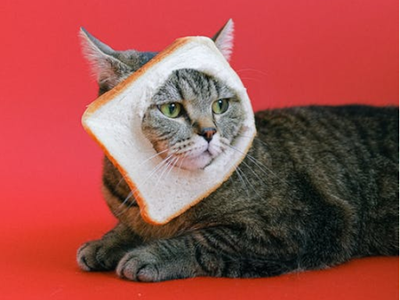
![Associated image for Best food for Ragdoll cats in the UK [Broken Down]](http://untamed.com/cdn/shop/articles/featured_best_food_for_ragdoll_cats_uk_400x300_crop_center.jpg?v=1646818249)
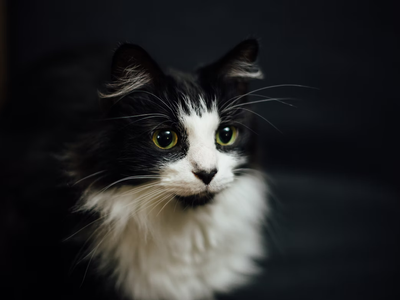
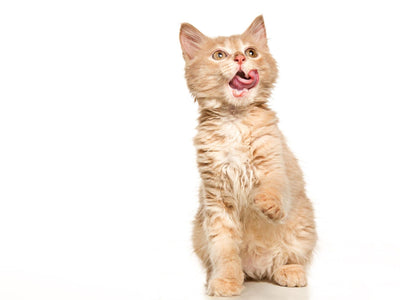

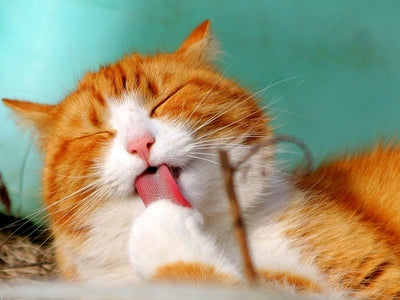
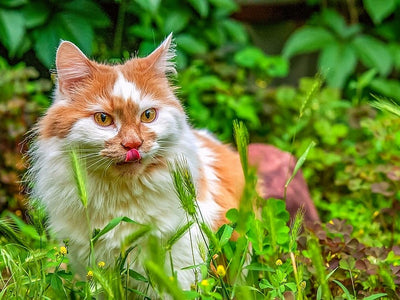

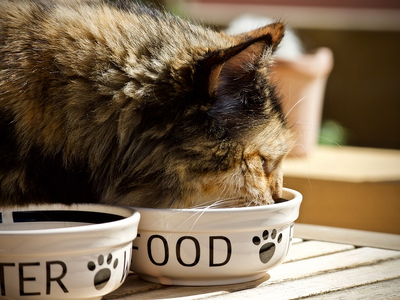
![Associated image for What human food can Sphynx cats eat? [Comprehensive list]](http://untamed.com/cdn/shop/articles/what_human_food_can_sphynx_cats_eat_Featured_400x300_crop_center.jpg?v=1648705074)

